#Trichoptera
Photo
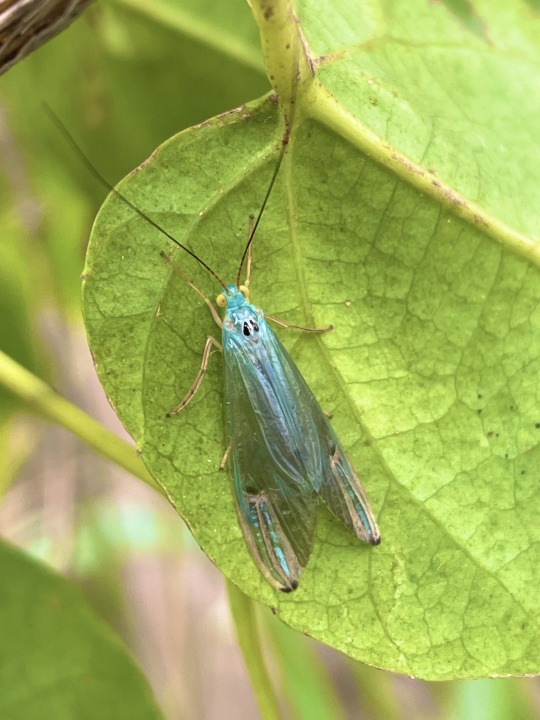
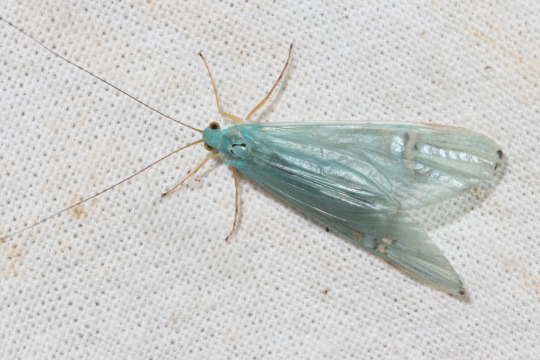
Blue net-spinning caddisfly, Polymorphanisus elisabethae, Hydropsychidae, Trichoptera
Found in Sub-Saharan Africa
Photo 1 by stefaneakame and 2 by thijsvalkenburg
#animals#curators on tumblr#insects#bugs#caddisfly#net spinning caddisfly#blue net spinning caddisfly#trichoptera#one nice bug
1K notes
·
View notes
Text
I was so happy to see one of my favorite examples of visual mimicry in Costa Rica! take a look at this Petrophila moth and a Nectopsyche caddisfly. notice anything familiar about the pattern they seem to share?


it’s the front view of a jumping spider! black round eyes in rows, and stripes for legs with gaps between them. the resemblance, especially seeing the mimics at actual size in person, is striking. both moth and caddisfly have a reflective white patch of scales around the eyes, making them seem reflective and alert.
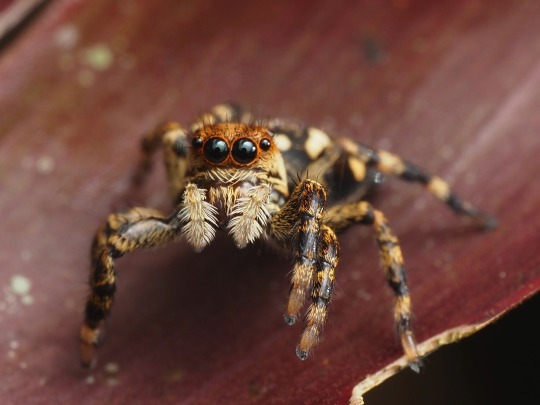
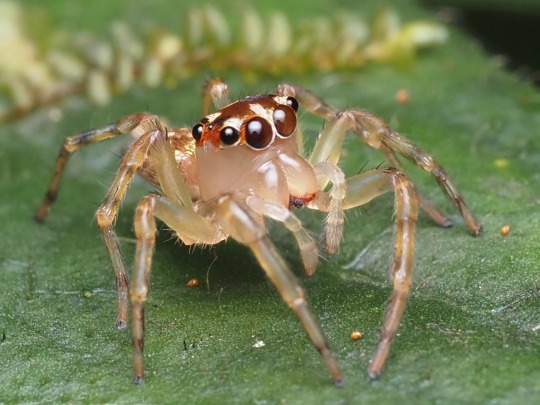
jumpers are active visual predators, a threat to small insects but also to one another, and have good facial recognition skills for members of their taxonomic family who might be rivals or predators. it’s thought that a jumping spider, viewing a mimic, might be scared off or even consider it a rival and start a territorial display, giving the mimic time to flee.

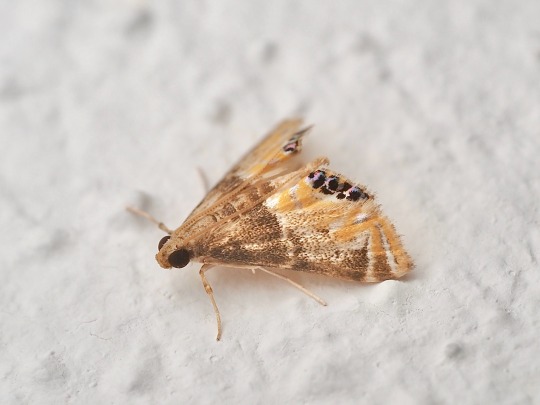

many Petrophila and their relatives in the subfamily Acentropinae have the jumping spider patterns, and I saw a few species with varying degrees of spideriness. there’s a surprising amount of other arthropods that mimic jumpers, too, from planthoppers to cockroaches and even other jumping spiders with false eyes.
1K notes
·
View notes
Text

Greena and Black Net-spinning Caddisfly (Macronema argentilineatum), family Hydropsychidae, order Trichoptera, Ecuador
Though it looks very much like small colorful moth, this creature is in a totally different group of animals... the caddisflies.
Find out more: Caddisfly - Wikipedia
photograph by Eerika Schulz
137 notes
·
View notes
Text
Taxonomy Tournament: Insects
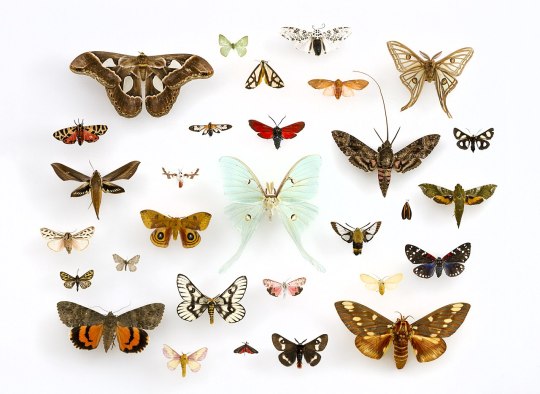

Lepidoptera. This order is made up of butterflies and moths. It is the second largest order (behind beetles) making up 10% of all described species of living things. They have large triangular wings and a proboscis for siphoning nectar.
Trichoptera. This order is made up of caddisflies, also called rail-flies, moth-like insects with aquatic larvae.
#animals#biology#polls#poll tournament#zoology#butterflies#moths#arthropods#insects#ecdytes#caddisflies#Lepidoptera#Trichoptera#0x62v0x9d#animal tournament#Animal Tournament Round 1
53 notes
·
View notes
Text

speculative biology: terrestrial caddisfly larvae (yes I know about bagworms, but I was inspired by this art) that live in your junk drawers and accumulate what they can find. this one has made its case out of bits of yarn it smooshed together into pompoms, plus various other baubles and notions.
#bug#bugs#bugblr#insect#insects#insect art#bug art#entomology#invertebrates#arthropods#insecta#id in alt#caddisfly#caddisfly larvae#caddisflies#Trichoptera#sedge flies#rail flies
377 notes
·
View notes
Text
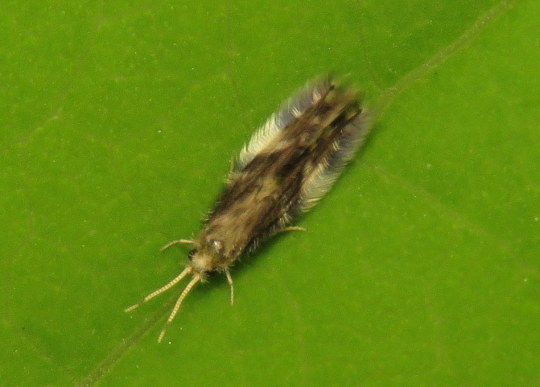
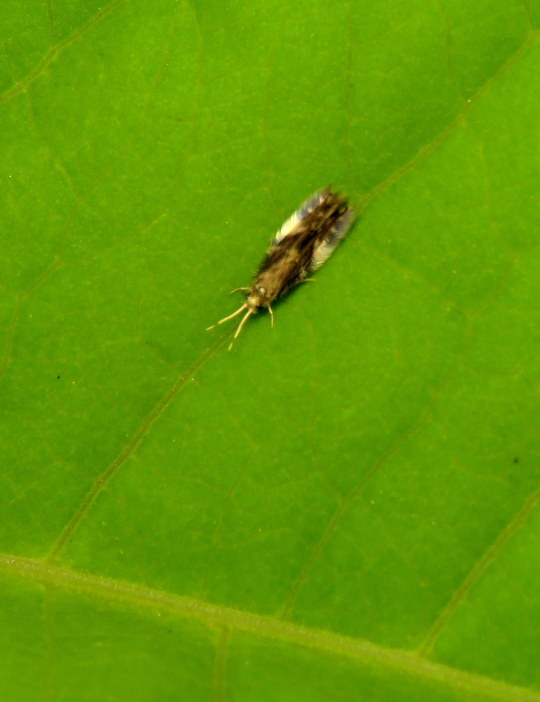
Bug of the Day
Ok, here is something tiny and fuzzy for today's Bug of the Day. This is a microcaddisfly - if you are familiar with caddisflies, they are in the same order but so so much smaller. This one is just a few millimeters long. If you are not familiar with caddisflies, then, well, this is just smol and fuzzy :-). I found it on a Japanese knotweed leaf (zoomed out photo to try to show you the scale).
#microcaddisfly#Hydroptilidae#Trichoptera#caddisfly#tiny#smol#fuzz#fuzzy#bug of the day#BotD#Japanese knotweed#knotweed
54 notes
·
View notes
Text
A particular Ichneumonid that I find fascinating is Agriotypus (Agriotypinae). It has a fascinating life cycle. They are parasitoids of Trichoptera pupae and pre-pupae. To quote the book - Ichneumonid Wasps (Hymenoptera: Ichneumonidae): their Classification and Biology by Gavin Broad, Mark R. Shaw & Michael G. Fitton:
"Females descend beneath the surface of the water and when submerged they are covered by a film of air, and the antennae and wings are laid back over the body. They periodically come up to the surface to replenish their air supply. Under water, they crawl about on stones and water plants and can adjust their buoyancy by scraping off some of the air film with the hind legs. They can take flight directly from the water surface (Clausen, 1931) or they can skim along it like pond skaters but with the wings providing propulsion."
In this case, in my drawing, the antennae are not laid back over the body, but I have seen pictures of Agriotypus submerged in water with the antennae pointing upward.

#hymenoptera#insect#wasp#wasps#entomology#apocrita#cartoon#comic#parasitica#Ichneumonidae#Agriotypinae#Agriotypus#Trichoptera#Caddisfly
103 notes
·
View notes
Text
This is a long shot but if someone can save me a few hours worth of research I'd be super grateful
I am a field technician doing stream monitoring and my local county department is developing a more detailed assessment method using family-level pollution tolerances rather than the more commonly used method of sorting specimens into either Philopotamidae vs. Hydropsychidae. Through my research I've found that tolerance varies between members of the same family, and it is useful to also be aware of genus-level tolerances. Unfortunately, I haven't been able to find a good reference for many genera (except for macroinvertebrates.org, love that site) I also don't have access to paywalled research papers and have been stuck with looking through old government reports and open-source journals. Is anyone willing to share a good paper/report/website with me that includes any information available for Trichoptera (and any other macroinvertebrate order) genera-level tolerance values?
(I tried posting on reddit but all the relevant invert forums are dead)
#wrenfea.exe#invertebrates#macroinvertebrates#trichoptera#caddisfly#biomonitoring#stream science#stream ecology#freshwater ecology#bugs#insects#larvae#larva#fishing#btw if anyone is interested in aquatic insects please look at macroinvertebrates.org its amazing#biology#marine science
11 notes
·
View notes
Photo

34 notes
·
View notes
Text


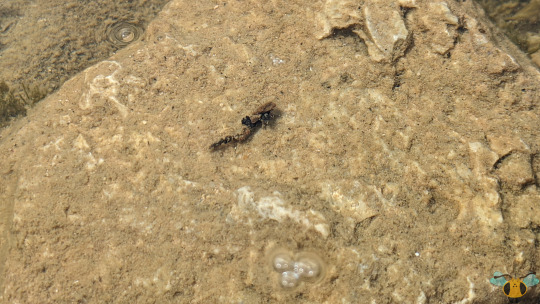

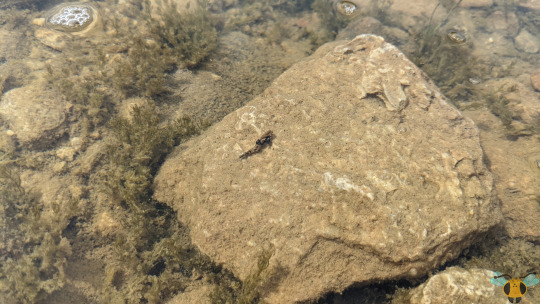


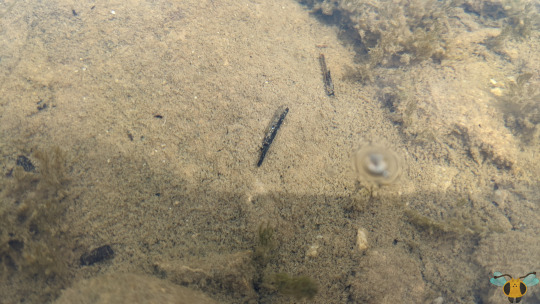
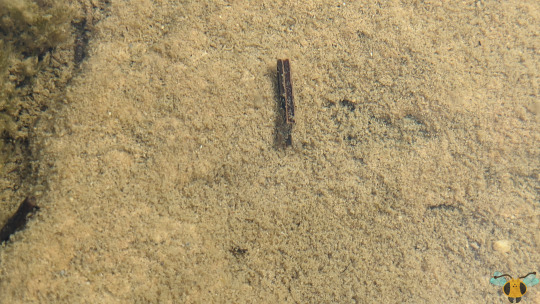

Caddisfly Larvae - Order Trichoptera
There are many mysterious insects that have the ability to live, hunt and flourish beneath the water's surface. In some instances, special adaptations are necessary in order to keep safe and remain inconspicuous while crawling among rocks and river plants. These Caddisfly Larvae have been previously seen in a video post recorded many years ago showcasing them in their various house-casings, the ways in which they might appear as debris in the water, and some examples of locomotion. The pictures of the larvae here are intended to provide a second look at the many houses they have built on their back. As can be seen, all materials of the river/streambed are fair game if they can be bound with silk. It appears there's still need for more renovations and material acquisition to completely conceal their bodies and fortify their "shell". As indicated by their size (but it could be a matter of the specie as well), these Caddisflies are still relatively small and possibly still in their early instars.
Do note: although these are "aquatic insects", the young of Caddisflies are called larvae, and not naiads or nymphs. Allow me to explain the difference between the three. By appearances, larvae and naiads do appear to have a lot in common since the young look dramatically different upon full maturity, but in reality it's more of an in-between with nymphs. The foundation of the designations come from the types of metamorphosis in the insect would. To be specific, insects with young called "larvae" metamorphose into their new adult form via a pupa (e.g. Beetles, Hymenopterans, and of course Caddisflies). Insects with young called "nymphs" molt into their adult forms over many instars, but there is no pupa nor drastic change in overall appearance or morphology (e.g. True Bugs, Orthopterans). Finally, insects with young called "naiads" also molt into the adult forms over many instars. However, they do not need a pupa to reach adulthood (there's a subadult stage) and there is drastic change in overall appearance upon reaching adulthood. Examples of naiad insects include Odonates and Stoneflies, and both orders are also water-dwelling insects. All this in mind, since a Caddisfly resembles an elongated crawler while young, pupates and then emerges (onto land) transformed into a tent-winged form, its young are called larvae, and while similar in appearance, Trichopterans are not Lepidopterans. Sigh, it's a great big bug world out there!
Pictures were taken on July 17, 2022 in Collingwood with a Google Pixel 4.
#jonny’s insect catalogue#ontario insect#caddisfly#caddisfly larva#caddisfly larvae#water insect#trichoptera#aquatic insect#insect#collingwood#july2022#2022#unidentified#entomology#nature#invertebrates
3 notes
·
View notes
Text
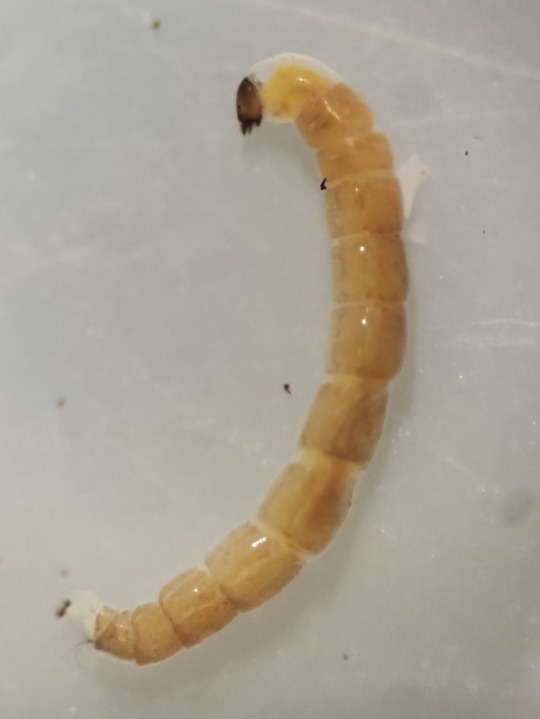

Chironomidae (midge) larva and Trichoptera (caddisfly) larva
4 notes
·
View notes
Text
@jambrandwich submitted: Let's look at some long leg lads! Or ladies! Can't really ask. I tried, but got no answer.





Who gave them permission to have such leggies?
Long leg lads and ladies!! I love them all. They are doing it for fashion I think so they don't need permission.
71 notes
·
View notes
Text
#1983 - Triplectides sp - Stick Caddisfly

The last NZ species I’ll be covering until the end of the year when I go over there myself at the end of this year and find more.
photo by @purrdence
Apart from 3 Baltic Amber fossils, the genus is found in Asia from India to Japan; in Indonesia, Papua-New Guinea, all of Australia; on South Pacific Islands including New Hebrides, New Caledonia, and obviously New Zealand; and in South and Central America. Aoteoroa has 5 species, but I don’t know which this one is.
The many species of Triplectides breed in most kinds of watercourse, including cold and warm, unpolluted to moderately polluted, permanent and temporary lakes, ponds, rivers and creeks. The genus is ubiquitous in Australian waterways, including temporary habitats in the central deserts, and is often the most common caddisfly genus encountered in benthic surveys.
The larvae construct mobile cases usually out of plant matter, but occasionally stones or the cases of other caddisflies. The plant cases can be a hollowed length of stick, or a tubular collection of plant fragments. Their hind legs have dark bands between the leg joints.
These Caddis are shredders, chewing up plant matter.
#trichoptera#caddisfly#caddis#triplectides#new zealand insect#leptoceridae#longhorned caddisfly#aquatic insect
5 notes
·
View notes
Note
15 and 43 for the ask game
First of all, thank you for the ask!! I'm buzzing!!
15: "most underrated bug?"
I don't exactly know how underrated these guys are but I'm going to go with snow scorpion flies (of the family Boreidae), tbh order Mecoptera in general is pretty underrated and I too am just learning more about it. I like these guys, they are closely related to fleas, are super adapted to a very specific enviroment (the boundary layer between snow and atmosphere, and are active during winter and cold moths) being directly dependent on the Sun's radiation for heat, the surrounding environment doesn't factor in much (unless, as the wiki states, put them in your hand and they'll die from your own heat, they can gain it, but not loose it easily). They are living on the edge huh. PLUS, they eat moss which is always great for no other reason than moss is great, love to see the cool organism interact AND I'm generally a big fan of insects that can survive in the cold!
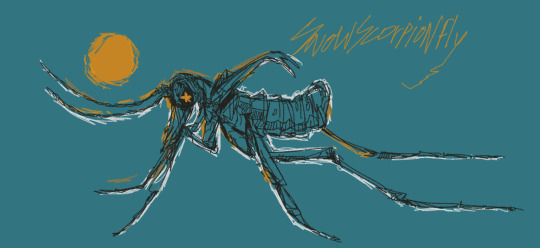
>long lengs so they don't touch the snow surface and loose the precious heat!
>Males have wings that aren't used for flying but for mating, females have... almost nothing for wings, vestigial as they get!

(Boreus westwoodi) I had to show how the wings worked, yeah.
Also since I'm on the topic of Mecoptera, I want to mention that female hangingflies (family Bittacidae) choose to mate or not to mate with a male depending on the quality of the prey the male brings her, isn't that a cool mating ritual! (so do scorpion flies, with their "nuptial gift" being saliva with yummy prey, the better the salive and more, the more time the mating lasts)
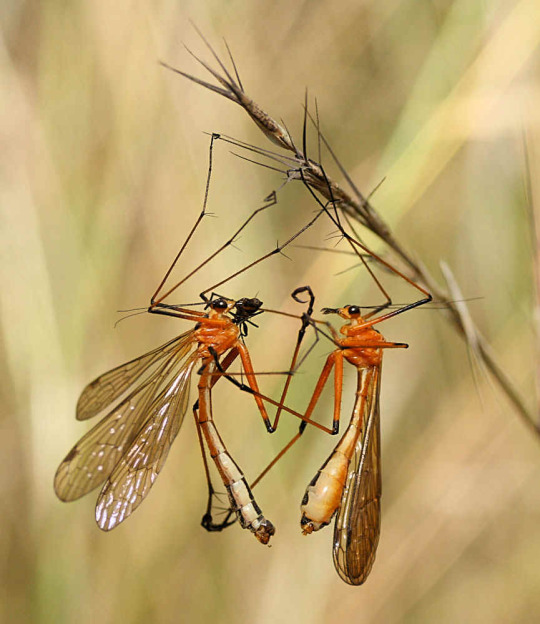
A reality TV show concept: "Will she take my prey? Will I take her [EGGS]?" (it's actually bareable because insects are cool)
43: which bugs do you think have the silliest faces?
Ok this one was super hard because there's wayyy too many and also I forgot 99% of all the insects I've ever know (cuz I do that when I'm asked lol), but here's a few funny photos from the interweb! Tbh, these lean towards cute more than silly (when in doubt tho, look at treehoppers)
Silly Number 1 (no order, except order Coleoptera!), Great-Diving Beetle! (Dytiscus marginalis)

"sir, that's a dog"
Silly Number 2, Some caddisfly larva (Stenopsyche sp.)
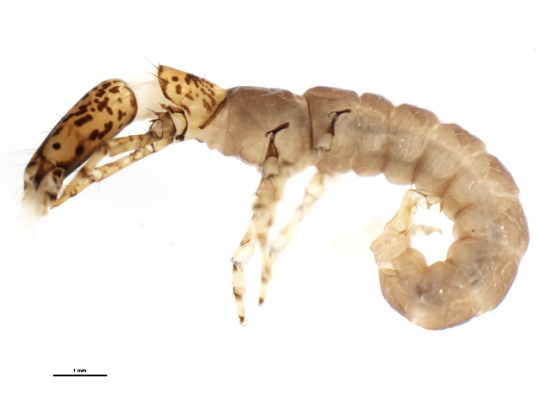
"sir, that's a ceetah"
Silly Number 3. Any Stinkbug ever (family Pentatomidae)

SIR THAT'S A-

Silly Number 4, this moss bug (Oiophysa distincta)
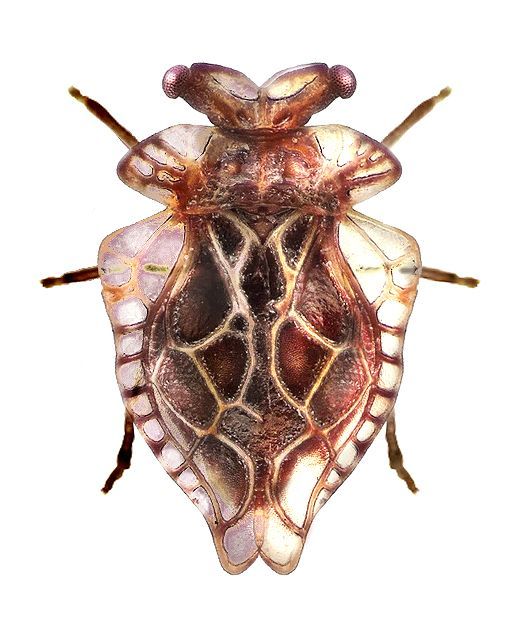
Couldn't find a photo of this lass facing the front, but I know, I know she's got potential.
OK, thank you for coming and thank you for the patience. That's all the bugs for now, but I'll be bugging ya'll soon with the other asks and the usual flood of typose and incoherence.
-signed a fishy chip
#you are totally allowed to hatecrime me for my writting style#Ty again for the ask#also dipterans rule just saying I could#<have written about them instead#have a nice day#also not double reading this cuz Im so hungry I need to eat and STOP TYPING FILLER#insects#mailbox✉️#ask#insect#bug#mecoptera#coleoptera#hemiptera#trichoptera#entomology#art#my art#insect art#doodle#man so many tags huh#fun facts#biology#cool facts#longpost#🦞chat#scorpionfly#nature#ok that is eeeeeenough of them
13 notes
·
View notes
Photo

Grannom Caddisfly- Brachycentrus subnubilis
4 notes
·
View notes
